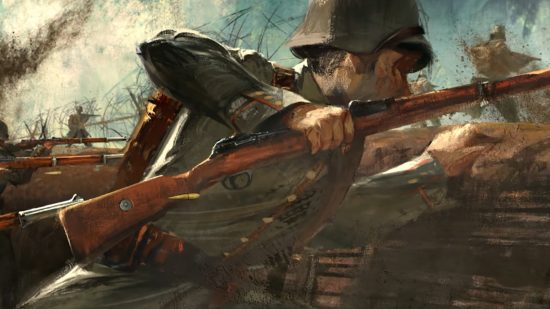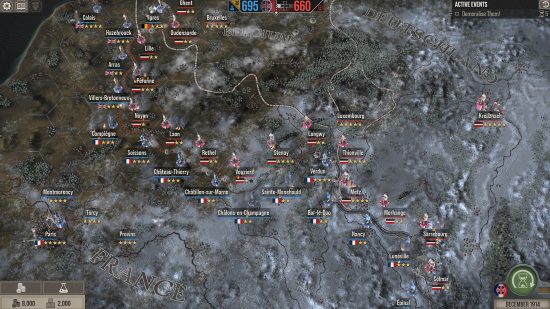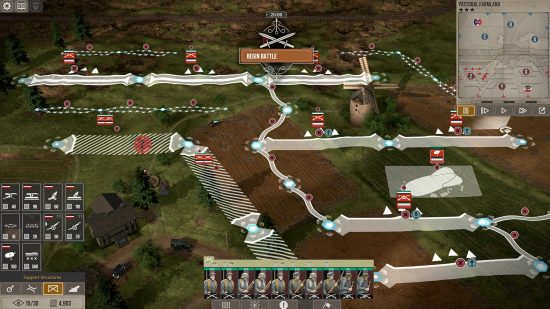Perhaps the most shocking thing about The Great War Western Front, Petroglyph’s upcoming historical RTS game, is how fast a platoon of men can simply vanish. Dozens of soldiers can be charging across a French battlefield one moment, and in the seconds it takes for a burst of machine gun fire to ring out or an artillery barrage to land, they’re gone.
In a Great War Western Front hands-on preview I joined recently, I had the chance to try out the upcoming PC game‘s tutorial, experiment a little with its complex campaign layer, and attempt one of the historical battles that recreate some of the clashes that defined the First World War. It’s a remarkable step for Petroglyph, a studio whose RTS chops date back to 1992’s Dune 2, and this early look grabbed my attention and held it.
As Rich explained in his preview from last year’s Gamescom, The Great War: Western Front is an invitation to take command during the conflict that would define and set in motion much of the 20th century. While that preview included a look at the real-time battles component, where Petroglyph is on familiar ground, this latest look at the game allowed me to tinker with the campaign, which is handled like an old-school, crunchy wargame – although fortunately, this one has the budget for prettier visuals than you’ll find in The Operational Art of War IV or Gary Grigsby’s games

The Western Front snaked its way across France, Belgium, Luxembourg, and Germany from 1914-1918, and it’s represented in The Great War on a map divided into hexagonal regions. Taking the reins as the Allies during the tutorial, my first order of business was to send several newly arrived American infantry corps to the town of Château-Thierry to reinforce the French position there.
Each region in The Great War has an assigned number of stars that represent how defensible it is. A single attack on a town like Château-Thierry won’t be enough to capture it – the Central Powers will need to wear it down through repeated assaults. The trouble is that by the time I get involved, Château-Thierry is down to its last remaining star – and German forces are massing across the line at Châtillon-sur-Marne.
Fortunately, the fresh American infantrymen aren’t all I have available. I buy two French tank battalions in Paris, and move them up along with an air wing. After I build some stationary siege artillery, Château-Thierry should be in better shape for when the inevitable happens, but it’s always good to be sure.
There’s plenty going on in the campaign layer to constitute a complete game. Regions can be improved with supply depots and field hospitals, there’s espionage and counter-espionage, and there’s always the delicate fun of making my way along a front line looking for a likely hex for my big push. However, while it’s possible to have the computer auto-fight your battles – as it would in a traditional wargame – The Great War: Western Front wants you to spend some time in the trenches and see the fighting first-hand.
These battles are in real-time, but they could hardly be more distinct from traditional RTS skirmishes. They begin with an involved preparation phase, during which both sides have the chance to build and improve trenches, place artillery pieces and observation balloons, lay concertina wire and mines, and even booby-trap the opposing side.
Once I’ve built a few new trenches and placed some machine gun nests, I drop my infantry companies in. From my bird’s eye view of the battlefield, the men are tiny, barely distinguishable from each other when they’re clumped up along a trench or marching in a column.
After I’ve done my battle prep, there’s another phase before the real-time tactical fighting begins: bombardment. The Allies and Central Powers spend days firing volleys of artillery at each other before committing troops, and during this phase any of your trenches – as well as the men sheltering in them and any nearby structures you’ve built – can be destroyed before the battle even starts.
When it does, I get to witness the devastating power those guns possessed, in real time. Running over open ground toward a trench full of protected soldiers is certain death, but these attacks are often supported by rolling artillery barrages – earth and stone erupt in geysers along a line in the ground, then again several metres ahead of the first. And again. And again. Each time the strikes get closer to my trenches, and my men keep their heads down. Enemy soldiers move up behind, hoping for a chance to clear out my trenchline with rifle fire, grenades, or flamethrowers.
Additional weapons and tactics can be found in the tech tree, which allows me to unlock devious techniques like undermining, which places a huge explosive underground on the enemy side of the field. Chemical weapons like chlorine gas can also be used in battle, which will annihilate companies that don’t have gas hoods available.
It’s grim stuff, and all thematically on point for the historical source material. I’m impressed, in a rather grim way, by how dedicated The Great War: Western Front is to the seriousness of the conflict itself, and the national scale of its brutality. The individual lives of soldiers are cheap and meaningless in the face of the industrial machines of war, and these terrifying new guns and chemical weapons leave the landscape itself scarred and devastated – the regions where battles take place are permanently changed by the battles you fight in them.
One potential concern is the game’s sheer complexity. Players familiar with Petroglyph from its more old-school RTS games may be shocked by how little of that comes into play in The Great War – not only do you have an unfamiliar real-time battle system that almost completely de-emphasises the kind of high-APM micro that won the day in Command and Conquer or Grey Goo, there’s also a full-fat wargame to learn on top of that.
After a couple brief hours with it, though, I’m keen to dig in. While there are no happy endings in the mud and trenches of World War I, The Great War: Western Front manages to pioneer some fresh ideas for RTS games, all while remaining reverent to its historical antecedents.
The Great War: Western Front release date is set for March 30, and it’ll be available for PC on Steam and the Epic Games Store. If you need something to keep you occupied in the meantime, be sure to check out our list of some of the best war games on PC, as well as rundown of all of the best strategy games – you’ll need keep your mind sharp, after all.


